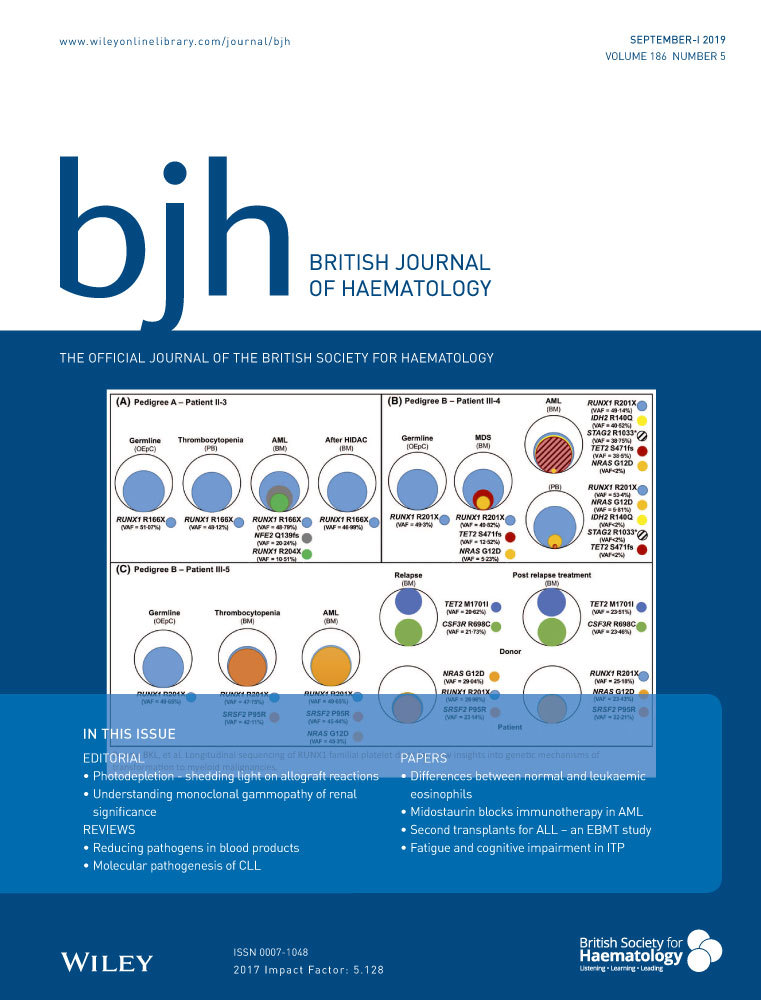Type 2 diabetes in adults with sickle cell disease: can we dive deeper? Response to Skinner et al
We read with interest the letter from Skinner, Nader and Connes and their comments on our recently published study on the burden of type 2 diabetes (T2D) in patients with sickle cell disease (SCD) (Zhou et al, 2019). The authors call attention to variation in T2D risk across patients with different SCD genotypes. Despite the fact that SCD is caused by single gene disorders, patients with SCD demonstrate a complex spectrum of complications and phenotypic heterogeneity that can be partially explained by the variability of fetal haemoglobin levels and co-inheritance of alpha thalassaemia. It is plausible to speculate that SCD patients of different genetic foundation could present distinct pathophysiology features, including lipid profile and anthropometrics, which in turn could influence the likelihood of being diagnosed with T2D.
To answer the questions raised by Dr. Skinner and colleagues, we must acknowledge the inherent limitations of administrative health databases in performing studies of disease burden. Herein we describe the challenges of further exploration of these currently available data and the necessary methodological considerations for such epidemiological studies, particularly possible information and selection biases.
We conducted analyses using a nationally representative, commercial health insurance claims database. While we employed validated algorithms in identifying eligible patients with SCD, we were not able to determine an individual patient's SCD genotype in this population. Studies determining specific SCD genotypes using International Classification of Diseases, Ninth Revision, Clinical Modification (ICD-9-CM) codes from hospital discharge data are problematic, resulting in both high rates of false positive and false negative results (Snyder et al, 2017). To better address whether the T2D burden indeed differs across different SCD genotypes, it is essential to link claims databases to other reliable sources containing genotype information, such as physician notes from electronic health records, laboratory results of haemoglobin electrophoresis, and/or SCD registries. One study indicated that the prevalence of T2D is lower in patients with HbSC and Sβ+-thalassaemia, compared to HbSS and Sβ0-thalassaemia subjects (Zhang et al, 2015). The identification of alpha thalassaemia using health insurance claims data is challenging due to the necessary interaction with the health care system in order to be included in the study. Significant underestimation of alpha thalassaemia may occur, partly due to the milder syndrome and lower utilization rates of diagnostic tests.
Similarly, we relied on diagnosis and procedure codes and pharmacy dispensing data to ascertain the presence of T2D and related medical conditions. Administrative health databases tend to lack information on measured laboratory values and anthropometrics, precluding a quantitative assessment of important confounding factors, such as lipid profiles and body mass index. Further, a large proportion of patients with SCD have increased iron store as measured by serum ferritin concentration (Ballas, 2001), and iron overload is associated with disordered glucose metabolism (Smiley et al, 2008). Thus, iron status should also be investigated as a potential indicator of risk in future prospective studies on T2D in SCD. Again, these deficiencies underscore the importance of linkage with other data sources to fully characterize the burden of T2D across SCD genotypes.
Future epidemiological assessments of disease burden in this population with greater rates of mortality should also account for competing risks and consider possible sources of selection bias. A competing risk is defined as an event where its occurrence precludes other events of interest from being observed and/or fundamentally alters the subsequent probability of the event (Gooley et al, 1999). In other words, longitudinal cohorts of SCD patients are inherently depleted of those experiencing premature mortality, with their follow-up stopped, and subsequently, lower rates of adverse health events (i.e., T2D diagnosis) are observed. Differences exist in life expectancy among SCD patients relative to the general population and also across different genotypes (Elmariah et al, 2014). Those with HbSC or other forms of milder SCD subtypes may have higher estimated prevalence of T2D because of their relative advanced age, which is a risk factor for T2D, compared to HbSS/Sβ0. However, due to the limitations of determining genotypes with certainty, past estimates of T2D prevalence were probably underestimated. We agree that future longitudinal analyses assessing the burden of T2D in the SCD population should consider both age and different genotypes due to higher mortality in more severe forms of SCD (do Nascimento et al, 2019).
Lastly, we propose a practical process incorporating screening of risk factors for T2D in the regular care of adult SCD patients. Those patients considered to be at higher risk for T2D could undergo confirmatory tests. Due to the lack of usefulness of glycated haemoglobin (HbA1c) in patients with SCD, clinicians may consider fasting-glucose or fructosamine for diagnosis and as measures of glycemic control (Kosecki et al, 2005). It is important that clear diagnostic criteria are developed and agreed upon.
In conclusion, we appreciate Dr. Skinner and colleagues' call for a deeper dive into this issue deserving clinical attention. To advance our understanding of T2D and T2D risk factors in subgroups of SCD patients, we need more real-world data containing unstructured clinical information and laboratory results. Additionally, going forward, competing risks and other epidemiological methodological issues should be considered when analysing and interpreting findings.




